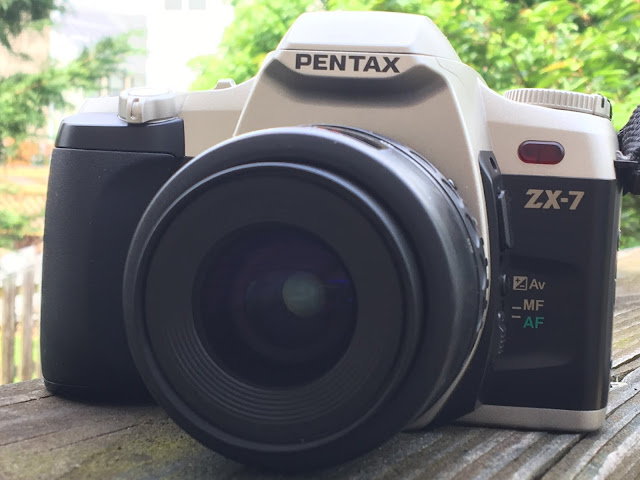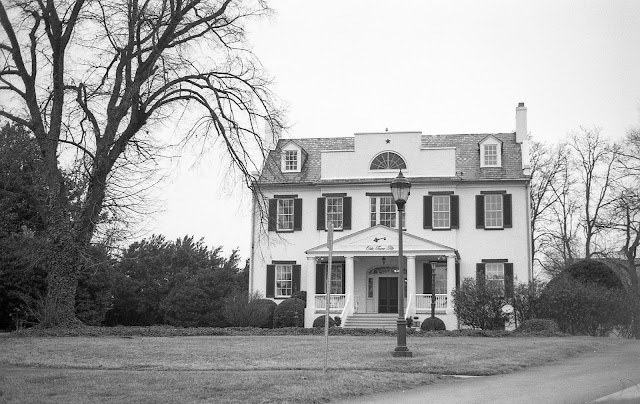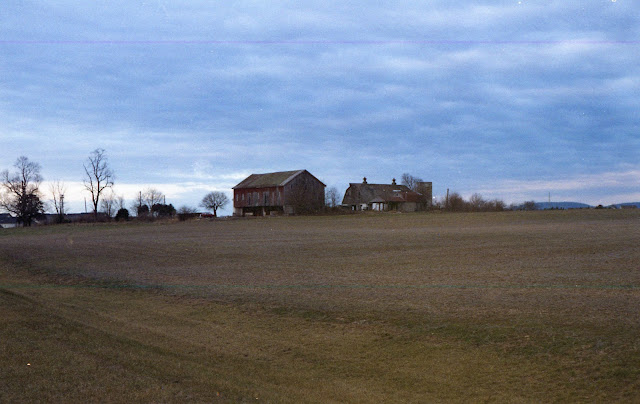Among my earlier film camera experiences was shooting staff K-1000 cameras as a photographer at my college yearbook in 1991. Later, when I became the editor of this yearbook, and enabled with some funds to replace the "K-Grands," I selected the P-30T model for offering an affordable choice with auto-exposure. Years later, when I was a Bus Operator, I snapped up an IQ-Zoom 80 QD to carry with me as a means to occasionally document (on slide film!) the buses, routes, and settings I had the privilege of driving.
When I got back into film shooting however, Pentax had been conspicuously absent my "wants list." In each of my earlier examples of using a Pentax, the camera model was selected more for a pragmatic aspect of cost benefit in a pricey camera market than it was selected for the shooting experience. The K-1000 simply was there already, and I didn't recall liking it much. The P-30T performed fine, but always felt a bit cheap. The IQ-Zoom was actually rather likable, and produced some decent results in favorable conditions, but seemed easily thrown by any varied lighting situation. Simply put, despite my interest in photography and sentimental ways, I was at a loss to conjure up nostalgia for shooting a Pentax.
You would at least think that given my exposure (pun intended) to the brand throughout the 1990's, I would at least be pretty well versed in "Pentaxonomy" but even this fails to ring true. Despite being a Popular Photography subscriber for most of the 1990's, I paid little in the way of attention to the Pentax brand, though much of this is due to the maker rarely getting much in the way of prominent attention at the time. While Canon, Nikon, and Minolta stole the show with their many new releases, Pentax's line-up generally sat humbly in the backdrop. There were some occasional feature stories on some of their more innovative releases, but most of the buzz tended to focus on the industry's "Big Three."
Or at least that's how I remembered it. But then as I was digging through some online copies of Popular Photography from 1999, I spotted an advertisement that suddenly spurred a memory for me:
Suddenly, I could remember being the twenty-something "Quirky Geeky Guy with a Camera Magazine" seeing this very ad back when it first was featured. I was totally enchanted by the idea of the light up dial featured on the ZX-7 at the time, but had not long beforehand picked up a Canon EOS Elan II-e, so this Pentax and its novel arrangement showed up just a hair too late for me to consider at the time.
But... here I was remembering this in a new era where the film cameras that cost several hundred dollars a decade and change ago could now be had for barely more than lunch money. I stole off to ebay, found a nice looking ZX-7 for under $20 and pulled the trigger with little hesitation.
The Pentax ZX-7 has a fairly basic look that is hardly intimidating to the amateur photographer.
Admittedly, I was making a buying choice based on little more than a novelty feature, but it wasn't a huge investment. Looking through what I could discover in documentation seemed to support that this Pentax could provide a new and welcome shooting experience for a person like myself who had been largely used to a much more manual experience. I certainly looked forward to giving it a try.
The Pentax arrived safely, and I wasted little time putting in a pair of CR2 batteries to fire it up and see what it could do. I generally liked the light weight and comfortable feel of the ZX-7 in my hands, and was generally pleased to see an informative but somewhat dim viewfinder to accompany the camera. I was also quite pleased to discover just how interchangeable Pentax lenses are. Unlike Minolta and Canon AF SLR's, the Pentax AF products readily take their legacy manual focus lenses. And while many of my Nikons feature a similar backwards compatibility, it can be very model-specific, requiring a lot of double checking via online lens-compatibility charts.
One great feature of the Pentax line is the readily availability to use manual focus Pentax lenses on any autofocus body. This privilege works in reverse as well.
The top view of the Pentax ZX-7 relies on a minimal amount of dials and buttons to control features. The main dial is actually the collar around the shutter release, unlike many models with a separate dial on top or back. This arrangement actually works pretty well.
And Yes, the main control dial DOES light up in full color as shown in the magazine ad. It does so when mounted to a Pentax AF lens locked into the program mode when the control dial is set to one of the scene modes on the top of the dial. It even does a neat scroll through the colors on the dial when started up, which you can see below:
Unfortunately, the lower settings for manual, aperture priority, and shutter priority do not light up, and nothing will light up when a manual focus lens is attached, or if the lens aperture ring isn't locked into the program mode. True, this feature is a bit gimmicky, but it can come in handy to some degree in low light situations. It also tends to make the camera feel a bit more contemporary than most others of its era. However, since my initial enthusiasm for it, I have to admit that I rarely see it now, as I'm usually shooting in aperture priority mode.
But the effective use of colors doesn't stop here. I was taken by pleasant surprise as I looked through the viewfinder to get a feel for the viewfinder and metering when I noticed the color of the LCD display change from green to yellow as I moved my view from a well lit area to a dim one and the shutter speed dropped to 1/30 of a second! This amazing feature struck me as a bit of pure genius on the part of Pentax. And while the illuminated dial atop the camera may be more gimmicky in nature, this little "Easter Egg" is far more useful.
View through the viewfinder. The right side information display aims to not be overbearing, and it succeeds a bit too well in that regard.
A couple of attempts to show the information in the side LCD information display. Note the green color in the image above that changes to yellow when the shutter speed drops to 1/30 of second or less.
The only problem with this arrangement is that the viewfinder and its LCD is overall a good bit more dim than many other SLR cameras, both contemporaries and predecessors. It's a bit too easy to begin to overlook the information in the viewfinder completely as its presence is so subtle. The one saving grace to some degree is that the color changing feature is most likely to be more noticeable in dim scenes where the change to the brighter yellow color is more likely to be noticed. I did actually wish that this same LCD would turn to a red color when an impossible setting was dialed in (such as a 1/1000 shutter speed priority in dim light with 100 speed film) but the ZX-7 instead resorts to the display flashing in yellow in these cases. Certainly effective, but not quite as neat as the potential for a tri-color LCD display.
Wow factors and their limitations aside, this Pentax does feel pretty smartly designed. Some features such as EV compensation are conveniently located where the user can find them without taking their eyes from the lens, while the viewfinder works to show the actual EV compensation settings on a scale, a nice improvement of many cameras that simply show a [+/-] icon that just show that some form of exposure compensation setting is being employed.
My initial thoughts of this Pentax were of a camera that did a lot of things quite smartly. The ergonomics and feature set were real winners and certainly made me want to go out and take a lot of pictures.
And the ZX-7 allowed me to do exactly that. I walked through Downtown Frederick on a lightly snowy morning and fired off 37 shots, thinking that one more shot from the parking deck would be the last of the roll. But the ZX-7 allowed me another, and another, and....
Something was certainly wrong. The ZX-7 made it all the way to 52 exposures on a 36 roll of Kentmere 100 before finally rewinding into the cartridge. My initial guess was the film was not advancing fully between exposures, and upon developing to see a patchwork of overlapped exposures across the entire roll proved this to be correct. Bummer, I'd just hoped that this was a happy accident on the part of Ilford somehow managing to pack an unreal amount of film into the canister.
As delivered, the ZX7 made maximum use of efficicency, squeezing over 50 photos onto a roll of Kentmere 100. The result was not quite as desired, requiring some retooling.
A look online revealed this was a particularly common problem with the Pentax ZX-7, and is largely attributable to Pentax electing to use plastic gearing and other cheap concessions that have caused this model to age prematurely over time. I tried the one possible fix I felt comfortable with, to do some light lubrication to the hub of film supply side to counter any resistance that the weak motors and delicate gearing may be encountering. I loaded in a 12 exposure roll of film and ran it through the camera in the dark. Upon passing shot #14, it rewound the film into the cartridge. While I couldn't be certain that the problem was fixed, the fact that it didn't go to shot #22 or so on this roll gave me just enough confidence to try another roll.
Fortunately, my efforts proved fruitful on the next roll, leading me to try a few more rolls of film through the camera over the months that followed. In that time, I can say that the shooting experience in the ZX-7 is nice but not incredible. Once the fascination with its technological niceties wears off, and you take note of some of the features on other cameras of the same era, you begin to notice the absence of these features on the ZX-7.
Some of these missing features, such as selectable metering patterns, are bigger losses than others obviously, but none keeps the ZX-7 from being a perfectly usable camera for the vast number of shooting situations confronting the hobby photographer, while the ability to readily use manual focus lenses. The biggest Achilles Heel for the ZX-7 is not from limitations in its feature set, but more the lack of a good build quality in the finished product.
And yet, given its issues, there is something very unique to me about the ZX7. Despite being 18 years old, the camera looks and acts in a very contemporary fashion; in fact far more so than AF SLR's made only a few years before it. It is not hard to think that the ZX7 looks more or less just like what a consumer grade film SLR made today would look like, if consumer grade film SLR's were made today. The lighted control dial and multi-color LCD in the viewfinder both appear current, as if someone from today went back into a time machine and released a film camera with the look and feel of today's technology.
After seeming to work out the bugs in the ZX-7's film advance, I got out for a few late Winter photos with this camera, finding a lot of love in using the manual focus 50mm f/2 for many shots.
Many of my photos with the ZX7 were taken wide open. There is some loss of sharpness in this photo evidenced most clearly in the faces at the base of the fountain.
A couple of samples of the same building can be seen both above and below. The first spotlights bokeh on the 50mm lens, the one below, going for more sharpness. Both seem to succeed at their desired objectives.
Under the challenge of some back light, the ZX-7 performs pretty admirably.
Another shallow shot taken in diminishing light works pretty well at showing the strengths of this bac lens.
I loaded some Ferrania FG200 in the ZX-7 and set about one morning to get a few more samples. Here, either camera or film has failed to get much in the way of usable detail.
Somewhat better is this try, which at least offers decent detail in the darker areas.
The built in flash on the ZX-7 pretty much acts like most built in flashes that quickly depletes beyond 10 feet or so.
Unfortunately, most scenes I took on the Ferrania rendered drably, victim of a perticularly dreary January.
One of the better shots from the Ferrania tests was this one. Still tough to really get a good idea of either film or camera's strengths.
This shot shows particular promise as far as the camera's capabilities.
One last Ferrania shot - a tad grainy, but well focused and full of character.
I elected to move up to an even faster, yet well regarded film for my last tries with the ZX-7, picking Fuji Pro 400H. Finally, I was being treated with more of an idea of what this camera was capable of.
Seeing a photo like this boosts my confidence in what the ZX-7 can do.
The 1/2000 top shutter speed is typically enough to allow shallow depth of field shots, even under full sun with fast film like Pro 400H. This one gave some excellent results.
Shifting back to a true landscape for this one, I'm impressed at the well done exposure and pleasing rendering.
Back to the narrow depth shots, I'm again very pleased with the ZX-7 and the 50mm f/2.
Under dreary light, the Pro 400H still manages a pleasing result on this camera.
Good subject isolation and good bokeh. I'm liking this.
Note the overlap of frames at left. Despite most of the gremlins being worked out of the ZX-7, there was occasionally a bit of a slip, as you can see here.
An attempt at a near symmetrical shot in spring time conditions in Frederick. I didn't quite have the time to make it more perfect.
Though Pro 400H is a good film, I wasn't always getting the best degree of detail in some lighting. Note the way that the willow tree really doesn't stand out. Regrettably, the actual scene showed a good bit more seperation.
Though the shooting conditions were more favorable with this film, I was certainly far more pleased with my results from the Fuji Pro 400 than the Ferrania.
Shots like this make me pleased to be shooting Pro 400 film through a Pentax.
Manage to barely get a bit of indistinct focus in the backdrop of this shot, but it doesn't quite seem to be enough to be a good example of shallow depth of field. It simply looks like a shot somewhat lacking in sharpness.
I've noticed some neat compression of the waving path of the fence posts on this stretch of road that I wanted to capture. I waited just a but too long to get the image I'd wanted.
I would say that this ZX-7 is where my "Pentaxonomy" all began, but that would be a lie, given my dabbles with some of its models in my photographic past. Fortunately, this model also didn't mark the end of my dabbles with some interesting Pentax models, so by all means: stay tuned!




































Thanks for the review. Just picked one of these up to play around with. Now finding film, getting it developed and taking some pics is all that's left to do ;-)
ReplyDeleteNow in 2021 read this and going to purchase one Mz7. Thanks for the review, let see what happens.
ReplyDelete